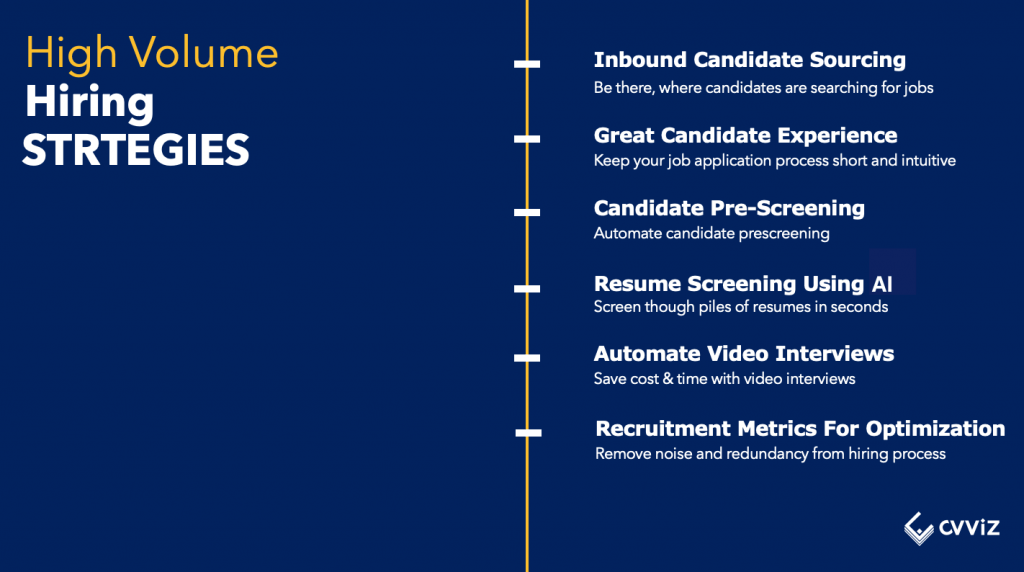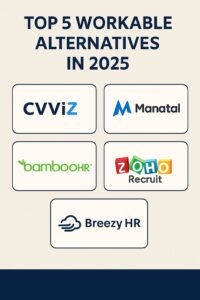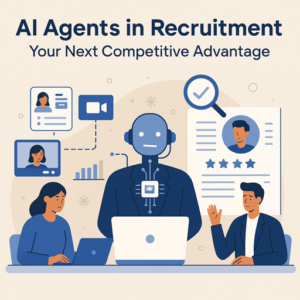There are two scenarios when a recruiter has to face an uphill challenge of high volume hiring. In the first scenario, a company decides to hire a large number of people for its growing business. Second, when you have a large number of people applying for the job. Sometimes, the recruiter has to face a mix of both.
High Volume Hiring
When a company wants to expand its operations or is in a growing phase, it needs to hire people for various positions, possibly in a shorter duration. For example, Amazon recently announced that it is going to hire 30,000 people in the next few months. This kind of hiring also referred to as bulk-hiring.
Similarly, there are times when a job position attracts a larger number of candidates than expected. For example, after the recession when the job market opens, there are many candidates waiting to apply for jobs. After the time of recession in 2000 and 2008, the number of resumes received for a job was so high that the term resume black hole was coined. It means, most of the resumes would go unnoticed.
We can expect similar trends post-pandemic in 2020.
Recently, in June 2020, one of the job postings on LinkedIn for an established brand saw more than 200 applications in the first 12 hours itself.
According to Jobvite, a regular job posting attracts an average of 50 candidates. In case of high volume hiring this number averages to 250.
If you are in the post-recession time then this number could easily surpass 250.
When you are hiring for vanilla skills (people with these skills are easily available) then you would expect a higher number of job applications. So, imagine if you are hiring for vanilla skills post-recession time! The average number of candidates applying for the job could go skyrocketing.
Also, you may not be hiring only full-time employees. You could be looking for temporary staff. For example, in the retail or hospitality industry, you need to hire more people during the holiday season.
Challenges We Face With High Volume Hiring
High volume recruitment is packed with challenges. You need to fill up many positions in the quickest time. You may also have to deal with a huge pile of candidate applications for most job positions.
Recruitment team size may not be big enough or it may not scale up even for bulk-hiring.
While you are dealing with high volume hiring you do not want to compromise on the quality of hire.
Let’s look into a few of these key challenges.
1. Time Limitations
You could be either bulk hiring or dealing with a high volume of job applications, in either case, you are racing against time to fill open job positions.
Your first challenge is to attract the right candidates to apply for jobs.
If you manage to get a good number of job applications then your next challenge is to quickly screen through resumes to reach top candidates. Many companies also phone screen candidates before they actually engage them in the interview process.
The aim is to engage the top candidates faster before they go off the market.
The recruitment process continues with phone screening, interview scheduling, job offer management, and onboarding.
One candidate may apply for more than one position.
Similarly, when you are dealing with a high number of job applications, you need to quickly screen candidates to identify the top candidates.
2. Collaboration Between Hiring Managers And Recruiters
Recruitment is a highly collaborative process. Collaboration between hiring managers and recruiters is the most crucial factor in the recruitment and selection process.
A hiring manager could be recruiting for multiple positions.
Often miscommunication between the hiring managers and recruiters leads to sourcing irrelevant candidates.
Also, for recruiters, collaborating between candidates and interview panel or hiring managers for interviews is a daunting task. Finding a time that suits to all the stakeholders is a cumbersome task.
Candidate tracking is another big challenge in high volume recruitment.
When you are hiring in bulk, collaborating with all the stakeholders get tough and this could lead to a stressful environment.
3. Team of Recruiters May Not Be Big Enough
Your existing team of recruiters maybe just big enough to support your regular recruitment. But, when a company decides to go for bulk-hiring, the team may fell short of hands.
Hiring more permanent recruiters could take time and could also hamper the speed of hiring.
A small team for high volume recruitment would mean a delay in every stage of hiring. Delay in communication. This could also lead to poor candidate experience and may push away many potential top candidates.
According to the Robert Half report, 57% of the candidates lose interest if you take too long to hire.
Ideally, in case of high volume hiring, hiring managers should take active roles not just in resume screening process but in other stages of recruitment.
4. High Cost of Hiring
Companies generally bank on employee referrals, job boards, and recruitment agencies for their hiring.
Posting on top job boards could be expensive.
Recruitment agencies charge anywhere between 10% to 30%. When hiring for a large number of positions this cost could skyrocket.
Keeping the cost of hiring lower could be challenging during high volume recruitment.
High Volume Hiring Strategy
Companies must devise a high volume hiring strategy in order to overcome several challenges imposed during high volume recruiting. The aim is to hire top candidates, faster while keeping the hiring cost minimal.
1. Opt For Inbound Candidate Sourcing
When you are dealing with high volume hiring, the best strategy to receive job applications is the inbound strategy. It means candidates are applying for the jobs on their own rather than recruiters reaching out and convincing them to do so.
Inbound candidate sourcing saves a huge amount of time because you do not have to call up every candidate to do prospecting. You know they are interested in the job.
So, how do you implement inbound candidate sourcing?
It is simple, you need to be present where the candidates are looking for jobs.
For example, candidates are searching for jobs on google. “Marketing jobs near me”. This Google for job search query should also return results from your career page.
When you want to hire for a large number of positions then you will want to use both organic and paid channels to attract top talent.
Let’s look at some additional candidate sourcing channels.
Paid And Free Job Boards
Job boards are the obvious choice when you want to publish your jobs. Job boards get a lot of candidates’ traffic. Your job would get maximum exposure.
Also, you must publish jobs to the relevant job boards. For example, if you are hiring candidates for tech roles then you could prefer leading job boards like Dice.
However, posting jobs on leading job boards could get expensive.
You must leverage free job posting options. There are free job posting sites that will allow you to post jobs for free. This will get you a good number of candidates. It will also help you in keeping hiring costs low.
Social Media Hiring
Social media is where everyone is; especially generation Z. You must be present on these new-age platforms like LinkedIn, Facebook, Instagram, etc.
There are also specialized platforms like GitHub, StackOverflow, Dribble, Behance that help you to reach people with niche skills.
Basically, use social media recruiting practices to attract and hire passive candidates.
Candidate Re-Discovery
Eventually, every company piles up the candidate database. These are the candidates that had shown interest in your company in the past.
They might not have made the final cut for various reasons but they were interested in your brand.
Leverage your old candidate database to rediscover talent.
You just need to use some methods like personalized email campaigns for relevant candidates.
Candidate discovery could be a great success if you could use AI to identify relevant candidates for each position.
Another way you can reach these candidates is by using conversational chatbots. You could do prospecting by initiating text-based conversations with these candidates.
Programmatic Job Ads
Programmatic job ads are the new mantra in the job advertising world. It uses AI to show job posting ads to the right people at the right time.
It is like building the persona of the ideal candidate and then showing job ads to candidates who fit the description.
Compared to traditional job advertising this could be more effective both in terms of cost and quality of the job applications.

2. Make Sure Of Great Candidate Experience
When you succeed in attracting candidates to apply for the job, you want to make sure they actually apply for the job.
You need to make sure you offer a great candidate experience. Candidates must get all the details about the job. Write a great job description that is compelling. They should get impressed by your employer’s brand. Your company career page is your best opportunity for employer branding.
Candidates must be communicated all the time.
Make sure your job application is mobile-friendly. As per recruitment statistics, 35% of candidates prefer applying to jobs using their mobile phones.
Keep your job application process short. Use minimal steps to receive job applications. You could use resume parsing to automatically extract important information from the resume so that a candidate does not need to fill all the details.
You must avoid building a resume black hole. When you have a large number of candidates applying to jobs, communicating with them gets tough. With a high volume of job applications, eventually, candidates never get to hear from companies after they apply for the job. This doesn’t go well with candidates and it could hurt your employer brand.
3. Set Up Candidate Pre-screening Questions
Eliminate phone screening as much as possible. Recruiters, often, after receiving a resume call up a candidate to ask a few important questions.
Why not make these phone screening questions part of a job application?
Candidates can answer all important prescreening questions at the time of applying for the job. For example, their salary expectations references they may want to share, etc.
Setting up a knockout question is another good idea. For example, if you are looking for people who need to work in a graveyard shift, then you can ask that as a knockout question rather than just mentioning it in the job description.
For junior positions, companies may opt for tech assessments. Candidates need to take tech or similar kinds of tests. Candidates who clear the test get the chance to proceed in the hiring recruitment and selection process.
4. Use Resume Screening Software To Screen Resumes
Resume screening is the biggest challenge of high volume hiring. Close to 86% of the resumes you receive are irrelevant. Imagine the number of hours spent just to discard those.
Resume screening takes time. If you spent your most productive hours in screening irrelevant resumes then you are bound to fall behind schedule.
Use AI for resume screening. Using AI you could screen resumes contextually. It means you would right away know what all candidates match to job requirements and hiring culture or your organization.
Resume screening software that uses AI can identify top candidates quickly. It makes sure you get to engage the right candidates for the right jobs.
AI resume screening could cut your time from days to minutes.
5. Schedule Video Interviews Automatically
Another time-consuming process is interview scheduling. A recruiter needs to go back and forth with candidates and the interview panel to fix the time slot.
Use interview scheduling automation that could fix the time slot for both, candidate and interviewer automatically based on mutual convenience.
In recent times, the popularity of video interviews has gone up. The recent covid19 pandemic has forced companies to opt for this option.
Video interviews help you save logistic costs. Eventually, it could help you save hiring costs.
6. Optimize Your Hiring Cost By Using Recruiting Metrics
When you think about high volume hiring, you would definitely think about hiring costs. You will have to make efforts in reducing the overall cost.
The best way to reduce the cost and efforts is by eliminating noise and redundancies from your hiring process.
Use recruiting metrics to track the performance of your recruitment process.
For example, as we discussed, you must track the performance of your candidate sourcing channels. If you are using paid job boards then track which job boards are leading to a better quality of candidates; and for what kind of roles. One job board may not suffice for all kinds of job roles. This will help you spend wisely on relevant job boards.
Leverage free job posting to minimize the cost.
Data-driven hiring will also help you find inefficiencies in your hiring process. For example, some candidates are being engaged for different positions at the same time, duplicate resumes being processed from various sourcing channels, etc.
Leverage Modern Recruitment Technology For Efficient High Volume Hiring
Your best bet to overcome the challenges of high volume hiring is the use of recruitment technology.
Your goal should be about minimizing repetitive tasks and spending more time engaging candidates. Using AI recruiting software you can achieve that. AI will help you intelligently automate these mundane tasks.
Be it recruitment marketing for sourcing candidates or resume screening you would need recruitment technology to effectively execute high volume hiring strategy.




